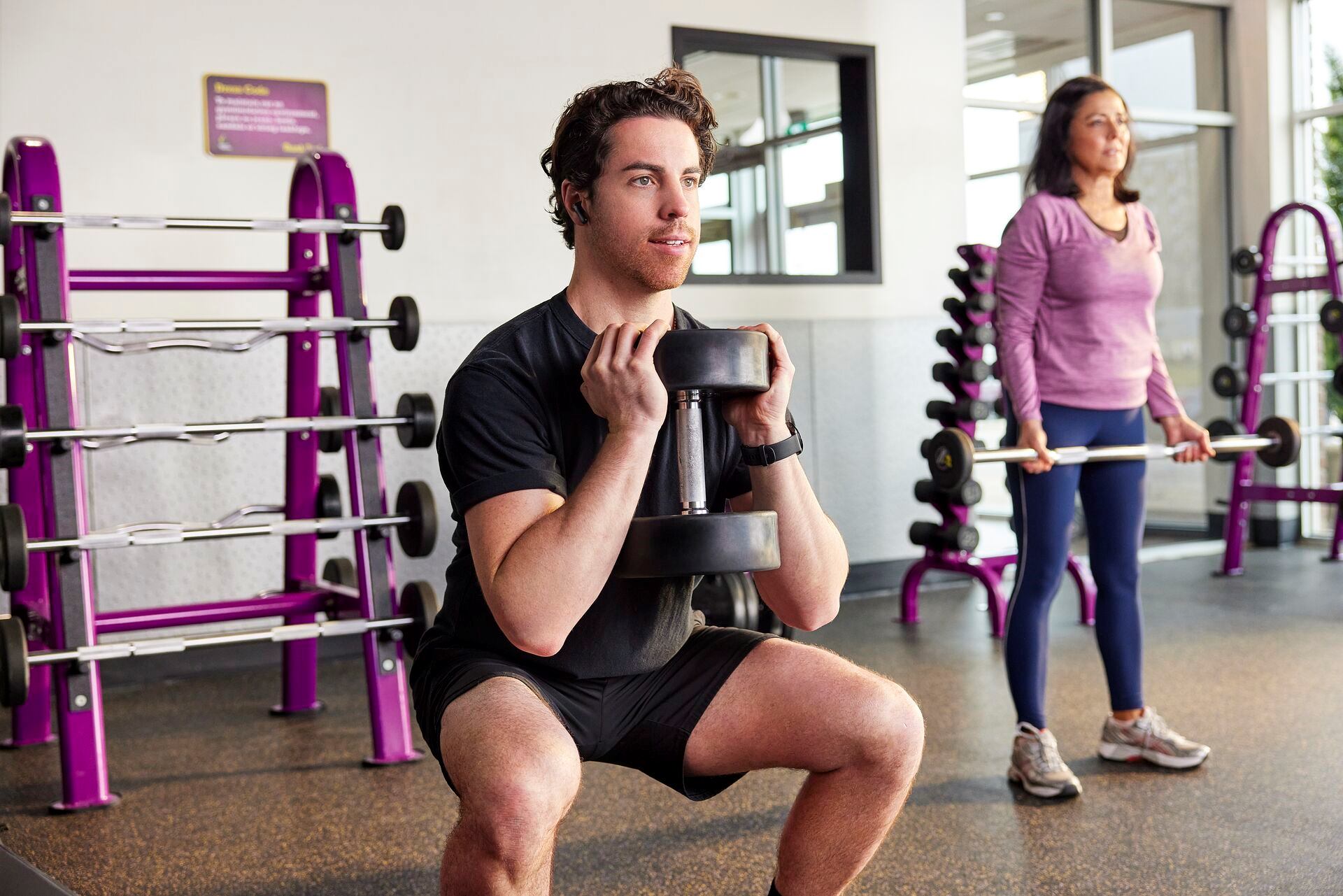Home>Misc>Featured>What Type Of Activity Would You Use To Improve Cardiovascular Endurance?


Featured
What Type Of Activity Would You Use To Improve Cardiovascular Endurance?
Published: August 28, 2023
Discover featured activities that can help improve your cardiovascular endurance and overall fitness. Find out what type of activity is best for you.
Introduction
Cardiovascular endurance is a crucial component of overall fitness and plays a significant role in maintaining a healthy lifestyle. It refers to the ability of the cardiovascular system, particularly the heart and lungs, to deliver oxygen and nutrients to the muscles during prolonged physical activity. Improving cardiovascular endurance is essential for enhancing stamina, boosting energy levels, and reducing the risk of cardiovascular diseases.
Engaging in activities that improve cardiovascular endurance not only has numerous health benefits but also contributes to weight management, stress reduction, and improved mental well-being. Whether you are an athlete looking to increase your performance or an individual seeking to improve your overall fitness, incorporating activities that target cardiovascular endurance is key.
In this article, we will explore the importance of cardiovascular endurance, its role in overall fitness, and the benefits of improving it. We will also discuss the principles of improving cardiovascular endurance and provide a range of activities that can help you enhance your cardiovascular fitness levels.
By understanding the significance of cardiovascular endurance and incorporating appropriate exercises into your fitness routine, you can optimize your physical performance, improve your overall health, and lead a more active and energetic life.
Importance of Cardiovascular Endurance
Cardiovascular endurance plays a pivotal role in maintaining optimal health and well-being. It refers to the ability of your heart, lungs, and blood vessels to deliver oxygen and nutrients to the muscles efficiently during prolonged physical activity. Here are some key reasons why cardiovascular endurance is important:
- Improved Stamina: When your cardiovascular endurance is high, your body becomes more efficient at supplying oxygen and nutrients to your muscles. This allows you to perform physical activities for extended periods without experiencing excessive fatigue or breathlessness.
- Enhanced Energy Levels: Regular cardiovascular exercise improves your body’s ability to utilize oxygen, thereby increasing energy production in the cells. This results in improved overall energy levels and reduced feelings of fatigue and lethargy.
- Reduced Risk of Cardiovascular Diseases: Engaging in activities that improve cardiovascular endurance helps to strengthen your heart and lungs. This reduces the risk of developing cardiovascular diseases such as high blood pressure, heart attacks, and strokes.
- Weight Management: Cardiovascular exercise is an effective way to burn calories and maintain a healthy weight. By improving your cardiovascular endurance, you can increase your calorie expenditure and boost your metabolism, making it easier to manage your weight and prevent obesity.
- Stress Reduction: Regular cardiovascular exercise releases endorphins, also known as “feel-good” hormones, which help to reduce stress and improve mood. It promotes better sleep, enhances mental clarity, and alleviates symptoms of anxiety and depression.
- Improved Heart Health: Engaging in activities that enhance cardiovascular endurance improves the efficiency and strength of your heart. It lowers resting heart rate, reduces blood pressure, and improves blood circulation, leading to a healthier heart and a reduced risk of heart-related conditions.
By prioritizing cardiovascular endurance in your fitness routine, you can enjoy these benefits and significantly improve your overall health and fitness levels. Whether you are an athlete aiming to boost your performance or an individual looking to lead a healthier lifestyle, cardiovascular endurance is a fundamental aspect that should not be overlooked.
Definition of Cardiovascular Endurance
Cardiovascular endurance, also known as cardiorespiratory endurance or aerobic fitness, refers to the ability of your cardiovascular system – specifically, your heart, lungs, and blood vessels – to sustain prolonged physical activity. It is a measure of how efficiently your body can supply oxygen and nutrients to your muscles during exercise, and how well it can remove waste products, such as carbon dioxide.
To understand cardiovascular endurance better, let’s break down the components involved:
- Heart: The heart is responsible for pumping oxygenated blood to your muscles, organs, and other tissues. It adapts and becomes stronger with regular aerobic exercise, allowing it to pump more blood with each beat.
- Lungs: The lungs are responsible for delivering oxygen to the bloodstream and removing carbon dioxide. As you engage in cardiovascular exercise, the lungs become more efficient at taking in oxygen and expelling waste gases.
- Blood Vessels: Blood vessels, including arteries, veins, and capillaries, transport oxygenated blood to the muscles and organs and carry deoxygenated blood back to the heart and lungs. Regular aerobic exercise enhances the flexibility and elasticity of blood vessels, improving blood flow and nutrient delivery.
Cardiovascular endurance is often measured by an individual’s maximal oxygen consumption (VO2 max), which represents the maximum amount of oxygen that can be utilized during intense exercise. Higher VO2 max values indicate better cardiovascular endurance.
Engaging in activities that improve cardiovascular endurance has numerous benefits for both athletes and individuals seeking to improve their overall fitness. These include increased stamina, improved energy levels, reduced risk of cardiovascular diseases, better weight management, enhanced mental well-being, and improved heart health.
By consistently engaging in activities that challenge your cardiovascular system, such as aerobic exercises, you can improve your cardiovascular endurance and optimize your overall physical fitness. It is important to gradually increase the duration and intensity of your workouts to ensure a safe and effective progression toward improved cardiovascular endurance.
Role of Cardiovascular Endurance in Overall Fitness
Cardiovascular endurance plays a vital role in achieving and maintaining overall fitness. It is a key component of physical fitness that directly impacts several aspects of your well-being. Here are some of the major roles that cardiovascular endurance plays in enhancing your overall fitness:
- Improved Physical Performance: Good cardiovascular endurance allows you to perform physical activities with greater efficiency and for longer durations. Whether you’re involved in sports, fitness training, or everyday tasks, having a strong cardiovascular system enables you to withstand physical exertion and perform at your best.
- Enhanced Stamina: Cardiovascular endurance determines your body’s ability to sustain prolonged physical activities without experiencing excessive fatigue. By improving your cardiovascular fitness, you can enhance your stamina and endurance levels, allowing you to engage in activities for extended periods without feeling exhausted.
- Effective Fat Burning: Engaging in cardiovascular exercises that raise your heart rate and breathing rate helps to burn calories and body fat. Regular aerobic exercise contributes to weight management, as it increases your metabolic rate and promotes fat oxidation.
- Cardiovascular Health: Having good cardiovascular endurance enhances the health of your heart and blood vessels. It increases the efficiency of your cardiovascular system, strengthening your heart muscles and improving blood circulation throughout your body, leading to a reduced risk of heart diseases.
- Reduced Risk of Chronic Diseases: Regular participation in activities that improve cardiovascular endurance promotes overall health and reduces the risk of chronic conditions, such as obesity, high blood pressure, type 2 diabetes, and certain types of cancers. It also helps to manage cholesterol levels and prevent the onset of metabolic disorders.
- Mental Well-being: Cardiovascular exercise stimulates the release of endorphins, the “feel-good” hormones that promote a positive mood and reduce feelings of stress, anxiety, and depression. Regular physical activity has been linked to improved mental well-being and cognitive function.
Incorporating activities that target cardiovascular endurance in your fitness routine is essential for achieving a well-rounded level of fitness. While strength training and flexibility exercises are also important, cardiovascular endurance forms the foundation for optimal overall fitness and should not be neglected.
By improving your cardiovascular endurance, you can enhance your physical performance, boost your energy levels, maintain a healthy weight, reduce the risk of chronic illnesses, promote heart health, and enhance your mental well-being. It is recommended to engage in a variety of aerobic exercises as part of your regular fitness regimen to maximize the benefits and achieve a balanced overall fitness level.
Benefits of Improving Cardiovascular Endurance
Improving cardiovascular endurance through regular exercise provides a wide range of health benefits and positively impacts various aspects of your well-being. Here are some of the key benefits that come with enhancing your cardiovascular endurance:
- Increased Stamina: By improving your cardiovascular endurance, you enhance your body’s ability to sustain physical activity for longer periods without experiencing excessive fatigue or breathlessness. This increase in stamina allows you to engage in daily activities or participate in sports and recreational activities with greater efficiency and endurance.
- Improved Energy Levels: Regular cardiovascular exercise stimulates improved oxygen delivery and utilization in the body, leading to increased energy production. As a result, you experience higher energy levels throughout the day, reduced feelings of fatigue, and improved productivity in both your personal and professional life.
- Weight Management: Engaging in exercises that improve cardiovascular endurance helps burn calories and promotes weight loss or weight management. Cardiovascular activities, such as running, cycling, or swimming, elevate your heart rate and increase calorie expenditure, contributing to a healthy body weight and reducing the risk of obesity.
- Reduced Risk of Chronic Diseases: Regular participation in cardiovascular exercise has been linked to a reduced risk of chronic health conditions, including heart disease, high blood pressure, type 2 diabetes, and certain types of cancers. It helps to maintain healthy cholesterol levels, control blood sugar levels, and improve overall cardiovascular health.
- Improved Heart Health: Improving cardiovascular endurance strengthens your heart muscles and enhances the efficiency of your cardiovascular system. Regular aerobic exercise promotes a lower resting heart rate, increases the heart’s pumping efficiency, and improves blood circulation. These benefits reduce the risk of heart disease, lower blood pressure, and improve overall cardiovascular function.
- Enhanced Mental Well-being: Cardiovascular exercise stimulates the release of endorphins, the “feel-good” hormones that elevate mood, reduce stress, anxiety, and depression. Engaging in activities that improve cardiovascular endurance promotes mental well-being, enhances cognitive function, and helps combat the negative effects of daily stressors.
- Improved Sleep: Regular aerobic exercise has been shown to improve the quality and duration of sleep. It helps regulate sleep patterns, promotes a deeper and more restful sleep, and reduces the frequency of sleep disturbances. Improved sleep quality contributes to overall well-being and supports healthy bodily functions.
By incorporating activities that improve cardiovascular endurance into your fitness routine, you can reap these benefits and enjoy a healthier and more vibrant life. Remember to start at a comfortable level and gradually increase the intensity and duration of your workouts to ensure safe and effective progress.
Principles of Improving Cardiovascular Endurance
Improving cardiovascular endurance requires a systematic approach that follows certain key principles. By following these principles, you can optimize your workouts and effectively enhance your cardiovascular fitness. Here are the principles to keep in mind when working to improve your cardiovascular endurance:
- Progressive Overload: To improve cardiovascular endurance, gradually increase the intensity, duration, or frequency of your workouts. This principle ensures that your body is continually challenged and adapts to the increased demands placed on it. Start with a manageable level of exercise and slowly progress over time to prevent injury and promote optimal improvements in endurance.
- Variety of Activities: Engage in a variety of cardiovascular exercises to target different muscle groups and prevent monotony. Activities like running, cycling, swimming, dancing, and rowing provide a diverse range of movements that challenge your cardiovascular system from different angles, enhancing overall endurance and preventing plateaus in your fitness journey.
- Consistency: Consistency is key for improving cardiovascular endurance. Aim to engage in aerobic exercises at least three to five times per week for optimal results. Regularity and consistency in your workout routine will help your body adapt and improve its ability to deliver oxygen and nutrients efficiently, leading to greater endurance gains.
- Gradual Progression: Avoid pushing yourself too hard or making sudden drastic increases in intensity or duration. Gradual progression ensures that your body can adapt and recover properly between sessions, minimizing the risk of injury or burnout. Increase your exercise duration or intensity by no more than 10% each week to allow for safe and sustainable improvements in cardiovascular endurance.
- Proper Recovery: Rest and recovery are essential components of any fitness program. Allow your body time to recover and adapt to the demands of cardiovascular exercise. Incorporate rest days into your routine to prevent overtraining and promote optimal performance and improvements in endurance.
- Monitoring Heart Rate: Monitoring your heart rate during exercise can help gauge the intensity of your workout and ensure you are training within the appropriate target heart rate zone. This zone is typically around 60-80% of your maximum heart rate. Using a heart rate monitor or tracking device can provide valuable feedback on your effort level and help you adjust your workout intensity accordingly.
- Proper Nutrition and Hydration: Fueling your body with a balanced diet and staying hydrated are vital for improving cardiovascular endurance. Adequate intake of carbohydrates, proteins, and healthy fats provides the energy needed to support your workouts and aid in recovery. Hydration helps maintain optimal bodily functions and prevents fatigue during exercise.
By incorporating these principles into your training routine, you can effectively improve your cardiovascular endurance and achieve your fitness goals. Remember to listen to your body, adjust the intensity as needed, and always prioritize safety and proper form during your workouts.
Types of Activities to Improve Cardiovascular Endurance
There are various types of activities that can help improve cardiovascular endurance. By incorporating these exercises into your fitness routine, you can effectively challenge your cardiovascular system and enhance your endurance levels. Here are some of the most effective activities to improve cardiovascular endurance:
- Aerobic Exercises: Aerobic exercises are activities that increase your heart rate and breathing rate for an extended period. These include activities like brisk walking, jogging, running, cycling, swimming, and dancing. Engaging in these exercises regularly helps improve cardiovascular fitness, as they require sustained oxygen delivery to the working muscles.
- High-Intensity Interval Training (HIIT): HIIT workouts involve alternating between intense bursts of exercise and short recovery periods. This type of training challenges your cardiovascular system by pushing it to work at high intensities for short durations. Examples include sprint intervals, bodyweight exercises, and plyometrics. HIIT workouts are time-efficient and effective for improving both cardiovascular endurance and overall fitness.
- Circuit Training: Circuit training combines cardiovascular exercises with strength training exercises in a sequence. It involves performing a set of exercises back-to-back, targeting different muscle groups, and keeping your heart rate elevated throughout the workout. This type of training challenges your cardiovascular system while also improving muscular strength and endurance.
- Cycling: Cycling is a low-impact cardiovascular exercise that can be done outdoors or indoors on a stationary bike. It is a great way to improve cardiovascular endurance while also increasing leg strength. Whether you cycle on hilly terrains or opt for spinning classes, cycling engages large muscle groups and provides an excellent cardiovascular workout.
- Running and Jogging: Running and jogging are high-impact activities that effectively improve cardiovascular endurance. They engage multiple muscle groups and elevate your heart rate, helping to increase aerobic capacity and endurance. Start at a comfortable pace and gradually increase speed and distance over time to avoid overexertion.
- Swimming: Swimming is a total-body workout that challenges your cardiovascular system while being gentle on the joints. The resistance of the water provides an excellent cardiovascular workout, and the continuous movement of swimming helps improve lung capacity and endurance. Whether you swim laps or participate in water aerobics classes, swimming is a great activity to improve cardiovascular fitness.
- Jumping Rope: Jumping rope is a simple yet effective cardiovascular exercise that can be done almost anywhere. It elevates your heart rate and engages your entire body while improving coordination and agility. Set a timer and aim for intervals of jumping rope, gradually increasing the duration and intensity as your endurance improves.
- Rowing: Rowing is a full-body exercise that engages multiple muscle groups and provides an excellent cardiovascular workout. Whether you have access to a rowing machine or prefer rowing on the water, this activity challenges your cardiovascular system and builds endurance. Focus on proper rowing technique and gradually increase your intensity and duration over time.
- Stair Climbing: Stair climbing, whether done on an actual flight of stairs or using a stair climber machine, is an effective way to improve cardiovascular endurance. It engages large muscle groups in your lower body and elevates your heart rate. Climbing stairs challenges your aerobic capacity while also enhancing leg strength.
- Dancing: Dancing is a fun and enjoyable way to improve cardiovascular endurance. Whether you participate in dance classes, follow along with dance workout videos, or simply dance to your favorite music, it gets your heart pumping and boosts your endurance levels. Dancing also offers the added benefits of improving coordination, balance, and mood.
Incorporating a variety of these activities into your fitness routine allows for a well-rounded approach to improving cardiovascular endurance. Remember to start at a comfortable level and gradually increase the intensity and duration to avoid overexertion. Consistency and regularity in performing these exercises will yield the best results in enhancing your cardiovascular fitness.
Aerobic Exercises
Aerobic exercises are an integral part of improving cardiovascular endurance. These exercises work to elevate your heart rate and increase oxygen consumption, building your aerobic capacity. Incorporating a variety of aerobic exercises into your fitness routine develops endurance, strengthens your cardiovascular system, and improves overall fitness. Here are some popular and effective aerobic exercises to consider:
- Brisk Walking: Brisk walking is a simple yet effective aerobic exercise suitable for people of all fitness levels. It can be done outdoors or on a treadmill. Start at a comfortable pace and gradually increase your speed to elevate your heart rate and challenge your cardiovascular system.
- Jogging and Running: Jogging and running are higher-intensity aerobic exercises that help improve cardiovascular endurance. They engage multiple muscle groups and increase your heart rate significantly. Start with shorter distances or intervals and gradually increase your duration or intensity as your fitness level improves.
- Cycling: Cycling, whether outdoors or using a stationary bike, is a low-impact aerobic exercise that builds endurance and strengthens the lower body muscles. Vary the terrain or resistance levels to challenge yourself and improve your cardiovascular fitness.
- Swimming: Swimming is a total-body aerobic exercise that is gentle on the joints. It engages various muscle groups and improves cardiovascular fitness while providing resistance against the water. Try incorporating different strokes and intensity levels to enhance your endurance.
- Dancing: Dancing not only is a fun and enjoyable activity but also an excellent aerobic exercise. Whether it’s Zumba, hip-hop, or ballroom dancing, it gets your heart rate up and challenges your endurance. Dancing also improves coordination, flexibility, and balance.
- Aerobic Classes: Joining aerobic classes like step aerobics, cardio kickboxing, or dance aerobics can be a great way to stay motivated and engage in structured aerobic workouts. These classes combine various movements and intensities to challenge your cardiovascular system while offering a fun, group workout environment.
When engaging in aerobic exercises, it’s important to pay attention to your form, wear appropriate footwear, and listen to your body. Gradually increase the duration and intensity of your workouts over time to avoid overexertion or injury. Aim for at least 150 minutes of moderate-intensity aerobic exercise or 75 minutes of vigorous-intensity aerobic exercise per week, spread out over several days.
Incorporating a mix of aerobic exercises into your routine not only improves cardiovascular endurance but also provides variety and helps prevent boredom. Find activities that you enjoy and that fit your fitness level, and make aerobic exercise a regular part of your fitness regimen.
High-Intensity Interval Training (HIIT)
High-Intensity Interval Training (HIIT) is a popular and highly effective form of exercise that can significantly improve cardiovascular endurance. It involves alternating between short, intense bursts of exercise and periods of active recovery. This unique training method challenges your cardiovascular system and engages both aerobic and anaerobic energy systems, resulting in improved endurance and overall fitness. Here’s how HIIT can help boost your cardiovascular endurance:
Increased Caloric Burn: The intense bursts of exercise during HIIT workouts require a significant amount of energy, leading to a higher caloric burn compared to steady-state cardio exercises. This can be beneficial for weight management and improving body composition. Additionally, the afterburn effect of HIIT, known as excess post-exercise oxygen consumption (EPOC), causes your body to continue burning calories at an elevated rate even after your workout has ended.
Improved Oxygen Utilization: HIIT pushes your body to work at high intensities, increasing its demand for oxygen. This leads to improved oxygen utilization efficiency by your muscles and cardiovascular system. Over time, this enhanced ability to utilize oxygen improves your cardiovascular endurance and overall fitness.
Time Efficiency: HIIT workouts are typically shorter in duration compared to traditional aerobic exercises. The high-intensity intervals are performed at near-maximum effort, requiring your muscles and cardiovascular system to work harder in a shorter amount of time. This makes HIIT an excellent option for individuals with busy schedules who are looking to maximize their cardiovascular fitness gains in a limited amount of time.
Versatility: HIIT can be performed with a wide variety of exercises, including bodyweight exercises, cardio machines, and even equipment-free workouts. This versatility allows you to customize your workouts based on your fitness level, preferences, and available resources.
Improved Anaerobic Capacity: The intense bursts of exercise in HIIT workouts engage your body’s anaerobic energy system. This system provides energy for quick, powerful movements such as sprints and high-intensity exercises. By regularly challenging your anaerobic capacity through HIIT, you improve your body’s ability to work at high intensities and recover more quickly during intense physical activity.
While HIIT can be highly effective in improving cardiovascular endurance, it is important to approach it with caution, especially if you are new to exercise or have any underlying health conditions. It is crucial to properly warm up before each HIIT session, maintain proper form during exercises, and listen to your body’s cues to avoid injury.
Incorporate HIIT workouts into your fitness routine by including short bursts of high-intensity exercises, such as sprints, jump squats, burpees, or kettlebell swings, followed by active recovery periods. Start with shorter intervals and gradually increase the duration and intensity as your fitness level improves. Remember to include adequate rest and recovery periods between HIIT sessions to allow your body to properly recuperate.
By incorporating HIIT into your training regimen, you can challenge your cardiovascular system, improve your endurance, and enjoy the multitude of benefits that this high-intensity training method has to offer.
Circuit Training
Circuit training is a dynamic and efficient form of exercise that combines cardiovascular activities with strength training exercises. It involves moving through a series of different exercises, known as stations, with minimal rest in between. This type of training challenges your cardiovascular endurance, improves muscular strength, and enhances overall fitness. Here’s how circuit training can benefit your cardiovascular endurance:
Cardiovascular Endurance: Circuit training incorporates cardiovascular exercises, such as jumping jacks, mountain climbers, or step-ups, which are performed continuously within the circuit. This helps elevate your heart rate and improve your cardiovascular endurance over time. The combination of these exercises with strength training elements makes circuit training a highly effective method for enhancing both muscular strength and endurance.
Muscle Efficiency: Circuit training involves performing exercises that target different muscle groups consecutively, with minimal rest in between each exercise. This constant movement challenges your muscles and cardiovascular system simultaneously, improving their efficiency and coordination. The continuous training stimulates adaptations in your cardiovascular system, making it more efficient in delivering oxygen and nutrients to your working muscles.
Calorie Burn: The combination of cardiovascular and strength exercises in circuit training increases your overall calorie expenditure during and after the workout. These workouts are designed to keep your heart rate elevated, which helps to burn calories and can contribute to weight loss or weight management goals.
Muscular Strength and Endurance: Circuit training not only improves cardiovascular endurance but also enhances muscular strength and endurance. Incorporating exercises such as push-ups, squats, lunges, and planks into the circuit challenges your muscles, promoting strength development. The combination of cardiovascular and strength exercises in circuit training helps improve your ability to sustain physical activity for extended periods without feeling fatigued.
Variety and Efficiency: Circuit training offers a wide range of exercises and can be tailored to meet individual fitness goals and preferences. With a variety of exercise options, such as bodyweight exercises, free weights, resistance bands, or cardio machines, you can design a circuit to suit your needs. Additionally, circuit training provides a time-efficient workout, as you can work on both cardiovascular endurance and strength simultaneously in a single session.
When structuring a circuit training routine, aim to include 8-10 different exercises that target different muscle groups. Perform each exercise for a set amount of time or a specific number of repetitions before moving on to the next exercise. Remember to maintain proper form and technique throughout the circuit, and adjust the intensity of the exercises based on your fitness level.
Circuit training can be a challenging and exhilarating way to improve cardiovascular endurance while simultaneously building strength. Incorporate it into your fitness routine regularly for a well-rounded and efficient workout that will enhance your overall fitness level.
Cycling
Cycling is a popular aerobic exercise that provides numerous benefits for cardiovascular endurance. Whether you prefer outdoor cycling or using a stationary bike indoors, this low-impact activity is suitable for people of all fitness levels and ages. Incorporating cycling into your fitness routine can help improve your cardiovascular fitness, build endurance, and strengthen your lower body muscles. Here’s why cycling is an excellent activity for improving cardiovascular endurance:
Cardiovascular Endurance: Cycling is a rhythmic and repetitive exercise that elevates your heart rate and challenges your cardiovascular system. It requires sustained effort and increases your breathing rate, helping to improve cardiovascular endurance over time. Regular cycling sessions gradually improve your heart’s efficiency in pumping blood and oxygen to your muscles, leading to increased endurance.
Low-Impact Exercise: Cycling is a low-impact activity compared to running or other weight-bearing exercises. The smooth pedaling motion minimizes stress on your joints, making it a suitable option for individuals with joint issues or those who prefer exercises with less impact on their bodies.
Leg Strength and Muscle Endurance: As a predominantly lower body exercise, cycling strengthens and tones the muscles in your legs, including the quadriceps, hamstrings, calves, and glutes. The resistance encountered during cycling, whether it’s against the wind or a higher gear, challenges your muscles and develops both strength and endurance.
Improved Lung Function: Cycling involves continuous deep breathing, which helps to expand lung capacity and improve respiratory efficiency. As you engage in regular cycling, your lungs adapt to the increased demand for oxygen, allowing for better oxygen uptake and delivery to your working muscles.
Weight Management: Cycling is an effective calorie-burning activity that can contribute to weight management and help reduce body fat. By increasing your heart rate and engaging in longer duration rides, cycling aids in calorie expenditure, which can be beneficial for those aiming to lose weight or maintain a healthy weight.
Reduced Stress Levels: Cycling is not only a physical exercise but also an opportunity to enjoy the outdoors and connect with nature. The rhythmic motion and release of endorphins during cycling can help reduce stress levels, elevate mood, and improve mental well-being.
When incorporating cycling into your fitness routine, start with a comfortable pace and distance and gradually increase the intensity and duration as your fitness level improves. Vary the terrain and resistance levels to challenge yourself and continue progressing. Consider joining cycling groups or exploring new routes to keep your rides interesting and motivating.
Whether you cycle for leisure, commute, or participate in organized cycling events, this activity offers a fun and effective way to improve cardiovascular endurance while enjoying the benefits of fresh air and exploring new surroundings. Remember to prioritize safety by wearing a helmet and following local traffic rules when cycling outdoors.
Running and Jogging
Running and jogging are two popular exercises that can significantly improve cardiovascular endurance and overall fitness. Whether you prefer a slow jog or a fast-paced run, incorporating these activities into your fitness routine offers numerous benefits for your cardiovascular health. Here’s why running and jogging are effective for improving cardiovascular endurance:
Cardiovascular Endurance: Running and jogging are high-impact activities that require continuous movement and engage multiple muscle groups. These activities elevate your heart rate, increase your breathing rate, and challenge your cardiovascular system. Regular running or jogging sessions gradually improve your heart’s efficiency in pumping blood and oxygen, leading to increased endurance.
Calorie Burning: Running and jogging are among the most effective calorie-burning exercises. They increase your metabolic rate and contribute to weight loss or weight management goals. The intensity of these activities, especially during high-intensity interval training (HIIT) workouts, promotes a higher calorie burn both during and after your workout.
Muscular Strength and Endurance: Running and jogging engage the lower body muscles, including the glutes, quadriceps, hamstrings, and calves. These muscles work in a repetitive manner to propel your body forward, leading to strength development and increased endurance. Regular running or jogging sessions target these muscle groups, promoting overall lower body strength.
Bone Health: The high-impact nature of running and jogging helps in stimulating bone growth and improving bone density. Regular weight-bearing exercises like running and jogging can contribute to better bone health and reduce the risk of conditions such as osteoporosis.
Mental Well-being: Running and jogging have been shown to have numerous mental health benefits. These activities release endorphins, the “feel-good” hormones, which can elevate mood, reduce stress, alleviate symptoms of anxiety and depression, and improve overall mental well-being.
It’s important to approach running and jogging with proper form and technique to prevent injuries. Begin at a comfortable pace, gradually increasing your speed and distance over time. Incorporating interval training sessions, alternating between periods of faster running or sprinting and slower jogging or walking, can help improve cardiovascular fitness more effectively.
Consider varying your running or jogging routine by exploring different terrains, participating in organized races, or running with a group. This can add variety and motivation to your workouts. Remember to wear appropriate running shoes and clothing for comfort and safety.
Running and jogging are versatile exercises that can be easily incorporated into your routine, regardless of your fitness level. Whether you choose to run outdoors, on a treadmill, or participate in organized running events, these activities provide an efficient way to improve cardiovascular endurance, burn calories, build lower body strength, and support overall well-being.
Swimming
Swimming is an excellent activity for improving cardiovascular endurance. It is a total-body workout that engages all major muscle groups while providing a low-impact environment for cardiovascular training. Whether you swim laps in a pool, participate in water aerobics classes, or enjoy open water swimming, incorporating swimming into your fitness routine offers numerous benefits for cardiovascular health. Here’s why swimming is a highly effective activity for improving cardiovascular endurance:
Cardiovascular Endurance: Swimming requires continuous movement against the resistance of the water, which elevates your heart rate and challenges your cardiovascular system. The consistent effort needed to propel through the water helps increase your lung capacity, improves breathing efficiency, and strengthens the heart muscle, leading to improved cardiovascular endurance.
Total-Body Workout: Swimming engages multiple muscle groups simultaneously, including the arms, shoulders, core, back, and legs. This full-body engagement increases muscle strength, endurance, and flexibility. The combination of cardiovascular and strength benefits makes swimming a highly efficient workout.
Low-Impact Exercise: The buoyancy of water reduces the impact on your joints, minimizing the risk of injuries and making swimming an ideal exercise for individuals with joint pain or those seeking a low-impact alternative to land-based exercises. Swimming provides a smooth, fluid motion that eases stress on the joints while still providing an effective cardiovascular workout.
Improved Lung Capacity: Swimming requires controlled breathing and deep inhalation, improving lung function and capacity over time. By consistently challenging your lungs with swimming, you can enhance your oxygen uptake and utilization, leading to improved endurance and better overall respiratory function.
Weight Management: Swimming is a calorie-burning exercise that can aid in weight management. It provides an excellent cardiovascular workout, promoting calorie expenditure and helping to maintain a healthy body weight. Additionally, swimming can help with weight loss efforts as it increases metabolism and supports overall fitness.
Reduced Stress and Impact on Joints: Being in the water has a calming effect and can help reduce stress levels. Swimming can provide a refreshing and meditative experience, allowing you to unwind and relax. Additionally, swimming is gentler on the joints compared to other high-impact activities, making it a suitable choice for individuals with joint conditions or recovering from injuries.
When incorporating swimming into your fitness routine, start with a comfortable pace and gradually increase your distance or intensity. As you progress, consider incorporating different strokes and challenging workouts, such as interval training or incorporating equipment like pull buoys or kickboards, to further improve cardiovascular endurance and muscle strength.
Whether you swim for recreation, as part of a fitness class, or competitively, swimming provides an enjoyable and efficient way to improve cardiovascular endurance, build strength, and increase overall fitness levels without placing excessive stress on your joints. Dive in and enjoy the many benefits that swimming has to offer for your cardiovascular health.
Jumping Rope
Jumping rope is a simple yet highly effective aerobic exercise that can significantly improve cardiovascular endurance. This fun and versatile activity can be done almost anywhere, making it accessible to people of all fitness levels. Incorporating jumping rope into your fitness routine offers numerous benefits for cardiovascular health. Here’s why jumping rope is an excellent activity for improving cardiovascular endurance:
Cardiovascular Intensity: Jumping rope is a high-intensity exercise that elevates your heart rate quickly, making it an efficient way to challenge your cardiovascular system. The continuous jumping motion engages your entire body, requiring enhanced oxygen delivery to the working muscles and increasing your overall endurance.
Calorie-Burning Potential: Jumping rope is a highly effective calorie-burning exercise. Its high intensity can help you burn a significant number of calories in a short amount of time, making it a great option for weight management or weight loss goals. The vigorous nature of jumping rope also promotes an increase in metabolism, which can lead to further calorie burn even after you’ve finished your workout.
Improved Coordination and Agility: Jumping rope requires coordination and agility, as it involves timing your jumps and coordinating the movements of your arms and legs. With regular practice, you develop better coordination skills, balance, and proprioception, which can translate into improved overall athletic performance.
Portable and Versatile: Jumping rope requires minimal equipment and can be done virtually anywhere, making it a convenient exercise option. You can easily incorporate it into your home workouts, take it on the go during travel, or include it as part of your gym routine. Additionally, you can vary your jumping rope workouts by adjusting the speed, trying different jumping techniques, or incorporating intervals and variations to keep the workout challenging and engaging.
Improved Bone Density and Strength: Jumping rope is a weight-bearing exercise that puts stress on your bones, promoting bone density and strength. Regular jumping rope sessions can help reduce the risk of developing osteoporosis and improve overall bone health.
When incorporating jumping rope into your fitness routine, start with shorter intervals and gradually increase the duration as your endurance improves. Begin with a comfortable pace and focus on maintaining good form, including jumping lightly on the balls of your feet and keeping your knees slightly bent for shock absorption. As you progress, you can try different jumping techniques, such as alternating feet, high knees, or double-unders, to further challenge yourself and improve cardiovascular endurance.
Jumping rope is a fun and effective way to improve cardiovascular endurance, burn calories, and enhance overall physical fitness. It offers a versatile and accessible exercise option that can be easily integrated into your regular fitness routine. So grab a jump rope and start jumping your way to better cardiovascular health.
Rowing
Rowing is an excellent full-body workout that can significantly improve cardiovascular endurance. Whether you row on a watercraft or use a rowing machine, this low-impact activity engages various muscle groups and provides an intense cardio challenge. Incorporating rowing into your fitness routine offers numerous benefits for cardiovascular health. Here’s why rowing is an effective activity for improving cardiovascular endurance:
Full-Body Engagement: Rowing requires coordinated movements of the upper body, lower body, and core muscles. It engages major muscle groups such as the legs, back, arms, and shoulders. This comprehensive engagement translates into increased cardiovascular demand and improved overall endurance.
Cardiovascular Intensity: Rowing involves continuous, rhythmic movements with resistance, challenging your cardiovascular system. The combination of aerobic and anaerobic energy systems used during rowing helps improve cardiovascular fitness by increasing heart rate and oxygen consumption.
Low-Impact Exercise: Rowing is a low-impact activity that is gentle on the joints, making it suitable for people with joint issues or those looking for a low-impact alternative to high-impact activities. The smooth gliding motion of rowing minimizes stress on the joints while still providing an effective cardiovascular workout.
Strength and Endurance Development: Rowing builds both muscular strength and endurance. The continuous resistance from the water or the rowing machine challenges your muscles, promoting strength development. As you continue rowing, your muscles adapt and develop endurance, allowing you to maintain higher intensity and sustain activity for longer durations.
Calorie Burn and Weight Management: Rowing is a calorie-burning exercise that can aid in weight management or weight loss goals. The combination of cardiovascular intensity and muscle engagement during rowing increases calorie expenditure, helping to create a calorie deficit that supports weight management alongside proper nutrition.
When incorporating rowing into your fitness routine, pay attention to proper form and technique. Begin with a warm-up and gradually increase the intensity and duration of your rowing sessions. Focus on maintaining a smooth and controlled stroke, using your legs, core, and arms in a coordinated effort. Vary your workouts by adjusting resistance levels or incorporating interval training to keep your rowing sessions challenging and engaging.
Whether you row on the water or use a rowing machine at the gym or home, this full-body workout is an effective way to improve cardiovascular endurance while developing strength and burning calories. Incorporate rowing into your routine for a challenging and rewarding cardio workout that works your entire body.
Stair Climbing
Stair climbing is a challenging and effective aerobic exercise that can significantly improve cardiovascular endurance. This activity involves repetitively climbing up and down stairs, using your lower body muscles and engaging your cardiovascular system. Whether you utilize stairs in your environment, a stair climber machine, or a stadium bleacher, incorporating stair climbing into your fitness routine offers numerous benefits for cardiovascular health. Here’s why stair climbing is a beneficial activity for improving cardiovascular endurance:
Cardiovascular Intensity: Stair climbing is a high-intensity exercise that elevates your heart rate quickly and challenges your cardiovascular system. It requires sustained effort and rapidly increases your breathing rate, helping improve cardiovascular endurance over time.
Calorie Burning: Stair climbing is a calorie-burning activity that can aid in weight management or weight loss goals. The intensity of stair climbing leads to increased energy expenditure, making it an effective way to burn calories and shed excess body fat.
Lower Body Strength Development: Climbing stairs engages muscles in your legs, including the quadriceps, hamstrings, calves, and glutes. The resistance encountered during stair climbing promotes strength development in these muscle groups, improving overall lower body strength and endurance.
Bone Health: The weight-bearing nature of stair climbing helps stimulate bone growth and improve bone density. Regular stair climbing can contribute to better bone health and reduce the risk of conditions such as osteoporosis.
Mental Well-being: Stair climbing is also beneficial for mental health. The release of endorphins during exercise can elevate mood, reduce stress, and improve overall mental well-being.
When incorporating stair climbing into your fitness routine, start with a comfortable pace and gradually increase the duration and intensity. Consider including interval training where you alternate between periods of climbing at a faster pace and recovery periods at a slower pace. Focus on maintaining proper posture, using your entire foot to push off each step, and engaging your core muscles for stability.
If you don’t have access to stairs, you can use stair climber machines at the gym or simulate stair climbing with step platforms. These provide a controlled environment that allows you to adjust the intensity and track your progress more easily.
Whether you climb outdoors, on machines, or with step platforms, stair climbing provides an effective way to improve cardiovascular endurance, burn calories, and strengthen your lower body muscles. So take the stairs whenever possible and incorporate dedicated stair-climbing sessions into your fitness routine to reap the cardiovascular benefits of this challenging and rewarding exercise.
Dancing
Dancing is not only a fun and expressive art form but also a highly effective activity for improving cardiovascular endurance. Whether it’s salsa, hip-hop, ballet, or any other style, dancing engages your entire body, gets your heart pumping, and challenges your cardiovascular system. Incorporating dance into your fitness routine offers numerous benefits for cardiovascular health. Here’s why dancing is an excellent activity for improving cardiovascular endurance:
Cardiovascular Intensity: Dancing involves dynamic movements and continuous aerobic activity, elevating your heart rate and providing a cardio workout. The varying intensities and rhythms keep your cardiovascular system engaged, improving endurance over time.
Calorie Burning: Dancing is a calorie-burning activity that can support weight management goals. The combination of cardiovascular intensity, movement variety, and full-body engagement helps to burn calories, aiding in weight loss or weight maintenance.
Whole-Body Workout: Dancing engages multiple muscle groups simultaneously, including the core, arms, legs, and back. Each movement requires strength, coordination, and flexibility, resulting in improved overall fitness and endurance.
Improved Coordination and Balance: Dancing requires coordination between different body parts, promoting improved balance, agility, and spatial awareness. As you practice and learn different dance movements, you enhance proprioception, which is the body’s ability to sense its position and movements.
Mental and Emotional Well-being: Dancing is a form of creative expression that can enhance mood, reduce stress, and boost mental well-being. The joy and self-expression associated with dancing can have positive effects on your overall mental health.
Flexibility and Range of Motion: Dancing involves a wide range of movements that improve flexibility, joint mobility, and overall range of motion. Regular dance practice can help increase flexibility, making movements more fluid and reducing the risk of injuries.
To reap the cardiovascular benefits of dancing, you can join dance classes, participate in dance fitness workouts, or even dance at home. Whether you’re following choreography, participating in a dance-based workout video, or freestyling to your favorite music, dancing provides an enjoyable and effective cardiovascular workout.
Remember to warm up before dance sessions, wear appropriate footwear, and gradually increase the intensity and duration as your fitness level improves. Explore different dance styles to add variety to your routine and find the ones that resonate with you the most.
So put on your dancing shoes, turn up the music, and dance your way to improved cardiovascular endurance and overall fitness. Embrace the rhythm, have fun, and enjoy the benefits of this dynamic and enjoyable activity.
Conclusion
Improving cardiovascular endurance is crucial for overall fitness and well-being. Engaging in activities that challenge your cardiovascular system helps enhance stamina, increase energy levels, and reduce the risk of cardiovascular diseases. By incorporating exercises that improve cardiovascular endurance into your fitness routine, you can reap numerous benefits, including improved heart health, weight management, reduced stress levels, and enhanced mental well-being.
There are various types of activities that effectively improve cardiovascular endurance. Aerobic exercises such as brisk walking, jogging, cycling, swimming, and dancing help elevate heart rate and improve lung capacity. High-Intensity Interval Training (HIIT) and circuit training provide intense bursts of exercise to boost endurance and burn calories. Cycling, running, swimming, and stair climbing offer the advantages of low-impact options that can be tailored to different fitness levels.
Jumping rope provides a fun and versatile aerobic exercise, and rowing offers a full-body workout that targets the muscles while improving cardiovascular endurance. Dancing combines creative expression with cardiovascular exercise, while stair climbing challenges the cardiovascular system and strengthens the lower body.
Incorporating a mix of these activities into your fitness routine allows for a well-rounded approach to improving cardiovascular endurance. Remember to start at a comfortable level, gradually increase intensity, and listen to your body to prevent overexertion or injury. Stay consistent, be patient, and enjoy the journey of improving your cardiovascular fitness over time.
By focusing on improving cardiovascular endurance through these activities, you can optimize your physical performance, enhance overall fitness, and lead a more active and healthy lifestyle.









